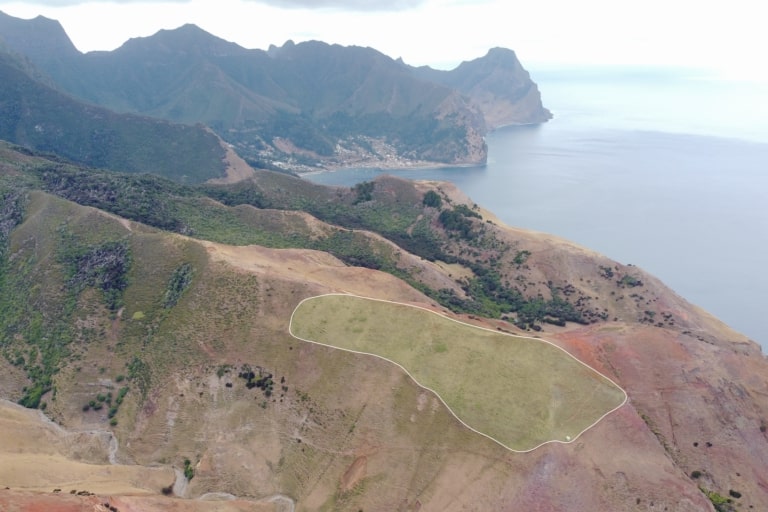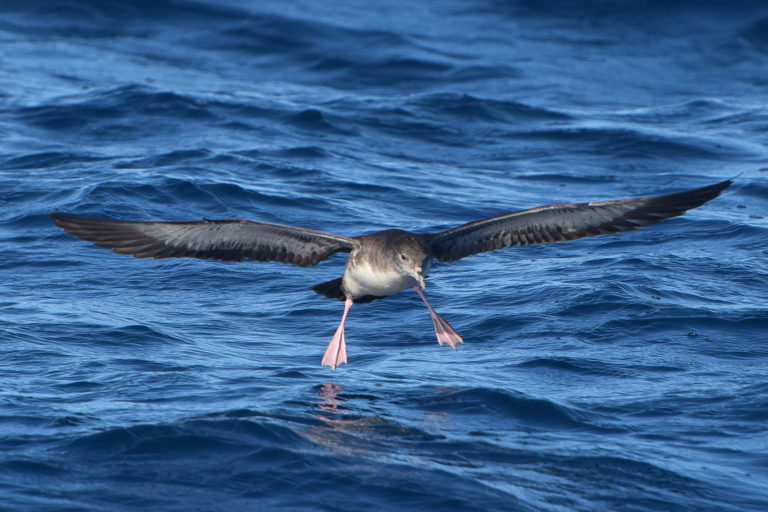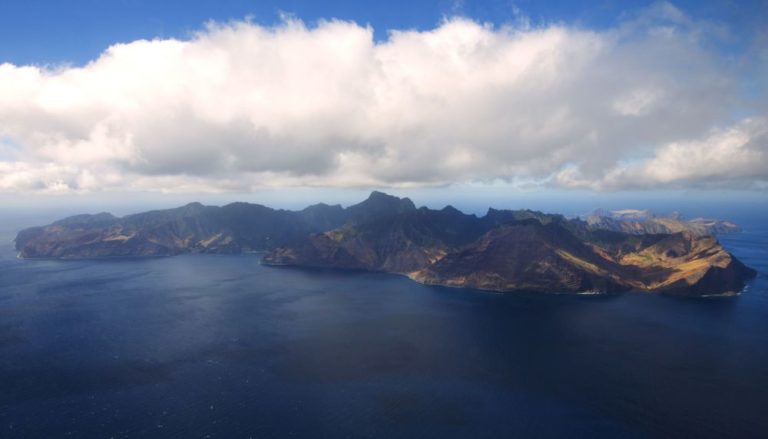Rich in both marine and terrestrial biodiversity, Juan Fernández Archipelago National Park (PNAJF) in Chile boasts species that live nowhere else in the world. Legends abound in this remote land, such as those that inspired the famous novel Robinson Crusoe — and which gives its name to one of its islands — of pirates, corsairs and even an ancient hidden treasure that eager seekers are still trying to unearth. This place is also an example of how concerted efforts can bring back to life places that are most degraded by human development. Guillermo Araya, the PNAJF administrator, says that despite being a territory with a unique ecosystem, the archipelago is considered one of the 10 eco-regions under greatest threat worldwide. This is due to human-driven activities and events, such as forest fires, the clearing of native vegetation, and the introduction of invasive alien species that have endangered the rich, fragile biodiversity of the archipelago. For years, scientists and park rangers in this archipelago in Chile have been working on the eradication of invasive species, with some success. Some of these measures have, for instance, led to a 40% increase in the number of breeding pairs of pink-footed shearwaters, a seabird species listed by the IUCN as vulnerable to extinction.
—
Made in Chile
According to Javiera Meza, head of the biological diversity conservation section of the National Forestry Corporation (CONAF), what stands out most about the PNAJF is its endemism — that is, the presence of unique species found nowhere else in the world. This protected area is home to 213 species of native flora, of which 135 are endemic. That gives it a rate of endemism of 63.4%, one of the highest in the world, surpassing even the more famed Galápagos Islands or Hawaiʻi.
This natural treasure, located in the Pacific Ocean 800 kilometers (500 miles) west of Santiago, the Chilean capital, was declared a Biosphere Reserve by UNESCO in 1977. It spans no more than 10,000 hectares (25,000 acres), its land area comprising three islands: Robinson Crusoe, the only one that’s permanently inhabited; Alejandro Selkirk, the youngest geologically and with the highest elevation in the archipelago; and the small island of Santa Clara.
To understand the formation of the archipelago, imagine a mountain range submerged in the ocean. Millions of years of seismic activity pushed the tops of the volcanoes up past the surface of the sea, creating the islands, says Héctor Gutiérrez, project manager for Oikonos, an environmental NGO. This new land eventually became home to various plant species from different parts of the world, which evolved in their Pacific isolation into forms never encountered elsewhere.
Some, like seeds from the Andes, arrived with the winds; others journeyed on the ocean currents — seeds and spores from as far away as New Zealand and Australia. One shrub found on the islands is a true living fossil, related to a species that used to live in Antarctica. Known as the false pepper, or Juan Fernández lactoris (Lactoris fernandeziana), it’s the only surviving member of an ancient lineage that dates back 69 million years.
The islands’ distance from the South American mainland means the only outside fauna that could reach them were birds, Meza says. There are 15 species of native birds that inhabit PNAJF: six species of seabirds and nine species of land birds, among the latter the red-backed hawk (Geranoaetus polyosoma exsul) and the gray-flanked cinclodes (Cinclodes oustaleti baeckstroemii). But the most emblematic and charismatic are the Juan Fernández firecrown (Sephanoides fernandensis) and the Juan Fernández tit-tyrant (Anairetes fernandezianus), both present on Robinson Crusoe Island, and the Masafuera rayadito (Aphrastura masafuerae), endemic to Alejandro Selkirk Island. Meza adds there is also a rich, but little studied, diversity of insect life in the park.
What is most striking, however, is that all the trees in the PNAJF forest are completely endemic. Among the many species here is one of the southernmost palm trees in the world: the chonta palm (Juania australis). It grows to a height of 10 to 15 meters (33 to 49 feet) and is considered in danger of extinction, Gutiérrez says, due to the loss and degradation of its habitat and as a result of invasive plant species such as the wild blackberry (Rubus ulmifolius), maqui (Aristotelia chilensis) and murtillo (Ugni molinae).
You might also like: Platypus Habitats Have Shrunk By Almost a Quarter Since 1990

The new fence is expected to keep invasive animals out of Piedra Agujereada on Robinson Crusoe Island. Photo: Héctor Gutiérrez/Oikonos/ Mongabay.
Invasive Species
The volcanic origin of the archipelago explains the geography of the three islands that make up PNAJF. The present wind and salinity conditions have caused the erosion of its topography, multiplying threats to its biodiversity.
Forest fires and the clearing of native vegetation were thought to have wiped out eight plant species. But two of them, both shrubs, have been rediscovered by CONAF park rangers. “In 2015, on Alejandro Selkirk … the species Chenopodium nesodendron was found and, in 2016, on Robinson Crusoe Island, the species Robinsonia berteroi was rediscovered on the top of Cerro El Yunque at 916 meters [3,000 feet] above sea level,” Araya says.
A “very silent but very aggressive” threat to the native forest is the spread of invasive plant species, aided by a bird called the austral thrush (Turdus falcklandii). Chilean law recognizes the thrush as a harmful species for the Juan Fernández ecosystem, since it feeds on the fruit and transports the seeds of invasive plants such as wild blackberry and maqui from one place to another.
Another threat to the archipelago’s endemic biodiversity comes from three invasive rodent species — Mus musculus, Rattus norvegicus and Rattus rattus — that eat more than 40% of the seeds in the endemic forest. Introduced European rabbits (Oryctolagus cuniculus), coati (Nasua nasua) and feral cats are also an issue, competing for food and habitat with the endemic species of the islands.
From the 1960s onward, the island of Santa Clara was used as a stockyard for the breeding and keeping of goats and sheep, which, along with a large population of European rabbits introduced in the 1930s as a source of protein, served to degrade the island’s ecosystem. “The European rabbit has generated fierce competition with the rest of the introduced mammals, limited the presence of livestock in Santa Clara and made it the dominant species, seriously affecting the native and endemic vegetation of the island,” Meza says. A 1999 estimate put the population density of rabbits on Santa Clara as high as 65 per hectare.
The livestock on Santa Clara served as a source of meat and wool for the town of Juan Bautista in Cumberland Bay, on the north coast of Robinson Crusoe Island.
Araya says measures are being taken to control the wild blackberry plants and restore the ecology of the native forest, along with projects aimed at eradicating the austral thrush and the rabbits and coatis in a sector of Robinson Crusoe Island.
These efforts aren’t new. Since PNAJF was created in 1935, CONAF has undertaken a series of initiatives to restore the degraded ecosystems of the islands.
One of the species most affected by the rabbit invasion was the pink-footed shearwater (Ardenna creatopus), declared in danger of extinction by the Chilean government in 2008. The shearwaters in PNAJF live most of their lives out at sea, spending the northern hemisphere summer off the coast of Baja California. From November to mid-May, they fly south, traveling up to 20,000 km (12,400 mi) to nest solely on three islands off Chile: Robinson Crusoe, Santa Clara, and Mocha Island. The latter is not part of the Juan Fernández archipelago; it’s located 620 km (390 mi) from Santiago, in the Bío Bío region.
The pink-footed shearwater digs burrows in the ground to lay its eggs, so rabbits represent a serious threat. The rabbits take over the birds’ burrows to raise their own young, leaving the single eggs laid by the shearwaters at the mercy of predators.
“The shearwater is losing its nesting grounds to the rabbits,” says Ivo Tejeda, executive director of the Network of Bird and Wildlife Observers of Chile.
Rabbit-culling measures in 2002 involved mass hunting and the use of state-regulated poisons, according to Meza. Following meticulous monitoring to verify the effectiveness of the cull, in 2003 Santa Clara was declared the first Chilean island from which invasive rabbits had been completely eradicated. Meza says this marked a milestone in the history of the fight against human-introduced species in PNAJF.
The rabbit eradication gave way to the restoration of the pink-footed shearwater population, “which saw its breeding pairs increase by almost 40% in three years,” Meza says.
The NGO Oikonos monitors the shearwaters here. “Our data indicate that shearwaters can withstand the presence of rabbits after laying their eggs, but they are vulnerable in the first stage of the season,” says Peter Hodum, program director for Oikonos in Chile.
However, there is still some way to go to permanently eradicate the other invasive species that threaten the shearwaters, such as feral cats, dogs, rats and coatis that prey on the birds and their chicks.

Pink-footed shearwater. Photo: Héctor Gutiérrez/Oikonos/Mongabay.
The Conservation of the Shearwater in the Park
Hodum says he’s been fascinated with seabirds ever since he was a biology student at Bowdoin College in Maine in the 1980s. During that time, he says, he read a chapter from a book on seabirds in Chile, and noticed Juan Fernández for two reasons: its unique community of seabirds, and the lack of information about its endemic species. These sparked his interest and the subsequent development of the first guidelines for the study of Juan Fernández’s pink-footed shearwater, he says.
Over the past 20 years, Hodum has studied the biology of the pink-footed shearwater and its conservation status, and developed research and environmental education programs for the local community based on the preservation of the environment.
A key project during this time has been the construction, ramped up this year, of a fence to protect the second-largest colony of shearwaters that nests on Robinson Crusoe from invasive species, specifically in the Piedra Agujereada sector, a place that is very difficult to access.
Pablo Manríquez, local coordinator for Oikonos in Juan Fernández, says that to get to the site requires a trip in a four-wheel-drive vehicle, followed by an all-terrain vehicle, and finally horseback. It’s an arduous journey, but necessary to protect the shearwater nesting grounds from invasive species.
In addition, the fence keeps the livestock out. The animals pose a constant threat, damaging half of all shearwater burrows when they step on them while grazing.
The fence construction began in 2012, initially only to keep the livestock away. Gutiérrez says that “although it was some protection, it was not effective.” So, in 2020, after obtaining funding through other international organizations, the fence design was improved and construction is underway. The fence will surround an area of 3.3 hectares (8.2 acres).
Gutiérrez says this initiative is capable of combating all the invasive species that threaten the shearwater, except for rats, which will still be able to get through the mesh. Gutiérrez says other techniques could be used to address this shortcoming, but that this would require greater funding and the use of other kinds of materials that would have to be transported by truck — too complex a task for a hard-to-reach place like Piedra Agujereada.
The fence project is a collaboration between CONAF, Oikonos and the local community. The residents of Robinson Crusoe are in charge of the construction, which Gutiérrez says presents a valuable opportunity in light of the job losses caused by COVID-19 pandemic. He adds it’s of the utmost importance that the local community be part of these conservation initiatives.
CONAF also plans to reforest the area contained within the perimeter of the fence, since in the past this entire sector was forest. It will draw from its seed bank for the effort. Gutiérrez says “that in the future, in addition to being a place of conservation, it will also be a local tourist attraction.”
Whether the pink-footed shearwater survives over time and manages to recover from its threatened status depends largely on the actions that can be taken in these islands off Chile, the only places on the planet where the species reproduces. “A significant part of the conservation of this seabird is played out in the actions that we take in Chile,” says Tejeda from the Network of Bird and Wildlife Observers.
That’s why the plan to protect the shearwater nesting area on Robinson Crusoe Island is part of the Recovery, Conservation and Management plan (RECOGE), led by the Ministry of the Environment in alliance with CONAF, the Undersecretariat of Fisheries and Aquaculture, the Institute for Fishing Promotion, and Oikonos.
Through this initiative, Gutiérrez says, the pink-footed shearwater will become the first marine bird protected within a national conservation plan.
You might also like: Invasive Species: How Concerned Should We Be?
Featured image by: Oceana I Manu San Félix.
This article was originally published on Mongabay, written by Barinia Montoya, and is republished here as part of an editorial partnership with Earth.Org.


















